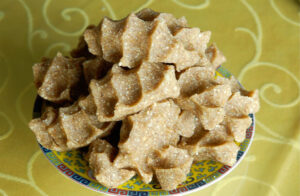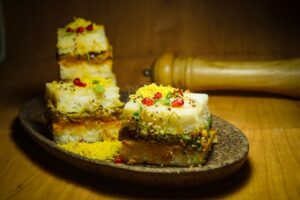
“Tell me what you eat and I’ll tell you what you are.”
Spoken by a true epicurean French lawyer in the 1800’s, these lines hold immense relevance to us even today. India is a country of 1.2 billion people, spread across thousands of acres who speak hundreds of different dialects that celebrate dozens of festivals each year! Our culture is a homogeneous mix of evolution and invasion- one which is obviously reflected in our food habits.
 Over the centuries, amidst unforgivingly cold Himalayas and scorching hot Thar desert, human life shook hands with these harsh conditions and thrived off of available resources. And ever since, our food palates have been majorly dictated by the climatic and geographic conditions.
Over the centuries, amidst unforgivingly cold Himalayas and scorching hot Thar desert, human life shook hands with these harsh conditions and thrived off of available resources. And ever since, our food palates have been majorly dictated by the climatic and geographic conditions.
So, how do terrains shape our diet? Let us answer this by taking you on this epicurean journey of highs and lows- from the Northern hilly areas of Ladakh to the colorful coastline of Goa through the western deserts of Rajasthan.
The jeweled crown of India, the ultimate tourist destination and our country’s own Switzerland- Jammu & Kashmir and Ladakh have their cuisine as varied as their scenic landscape. Ladakh, being at a greater altitude than J&K, is quite influenced by Tibetan cuisine. Since vegetation is scarce and winters can be exceptionally harsh, Laddakhi people rely heavily on Yak and goat meat and dairy products. Although not spicy, their food is hot from the ginger, cloves and chillies used in broths. One of their staple food, Thukpa, is a noodle soup with seasonal vegetables, meat and lentils. Another porridge like dish Tsampa is made from mixing barley flour and salty tea.


As we descend towards a denser civilization in J&K, the food becomes more colorful and spicy. Here, too, people rely immensely on meat; and rice is their staple food. The vast variety of flavors comes from the cultivation of spices in J&K. A few of the famous dishes include Yakhni Pulao, a rice dish flavored with whole spices and yogurt-based mutton gravy, and our beloved Rogan Josh.
Amongst the sea of Kashmiri dishes, one which stands out the most is Wazwan. It is a rice-based meal eaten with ample varieties of meat preparations, again laden with spices. Heaps of rice is served with many types of kebabs, Rogan Josh and other gravies. A traditional Wazwan meal can have up to 36 courses! This meal is generally eaten in a group of four during social functions and festivals.
Wazwan meal in our bucket list- added!
As the terrain gets flatter towards the west, the food becomes spicier and heavier. Delhi, Punjab and Haryana use large quantities of butter and cream to flavor their food. Along with this, the spice quotient also increases.
Whether its Chandani Chowk ke Chole Bhature or Makke-di-Roti Sarso-da-Saag, the flavors are unmatched. Culinary practice of each state reflect its biodiversity- Punjab and Haryana being the top cultivators of cereals like wheat, Jowar and Bajra- their staple diet consists of chapattis and they seldom eat rice.
 Moving further west in the desert of Rajasthan, one can find a magnificent saturation of spices. Once ruled by the mighty prideful Rajputs, their food still reflects the same pride and hospitality. Whether it is the delicious trio of Daal Baati Churma or the sugar-laden Ghevar, you are sure to get a taste of the much talked of Rajput grandeur with every Rajasthani spread. Don’t get fooled though, one of the spiciest curries in India- Laal Maans also comes from the land of Rajputs. Spicy hot curry in blazing hot summers; seems counterintuitive, right?
Moving further west in the desert of Rajasthan, one can find a magnificent saturation of spices. Once ruled by the mighty prideful Rajputs, their food still reflects the same pride and hospitality. Whether it is the delicious trio of Daal Baati Churma or the sugar-laden Ghevar, you are sure to get a taste of the much talked of Rajput grandeur with every Rajasthani spread. Don’t get fooled though, one of the spiciest curries in India- Laal Maans also comes from the land of Rajputs. Spicy hot curry in blazing hot summers; seems counterintuitive, right?
Actually, it is basic anatomy and science. Centuries ago when there were no refrigerators, food in hot climate would go bad quickly. So to preserve it for longer duration, women would add lots of spices since they have antimicrobial qualities. This pattern continued, and people developed a taste for ‘masaledaar khaana’! Now, when eating spicy food in summer, metabolism kicks our body temperature up a notch, which causes profuse sweat dispersion, which in turn cools our body faster.
A classic example of killing two birds with one stone!
 The contrasting flavors of Gujarat and Maharashtra, further down west in our map, lay the foundation of two harmoniously coexisting neighbors. While on one hand, we have the fiery spicy Misal Pav, we have the sweet but standout flavors of Khaman Dhokla and Kadhi on the other. While we relish the coconut prawns curry from Malvan, we have grown to love the sweet and tangy flavors of Gujarati Dabeli Dhokla.
The contrasting flavors of Gujarat and Maharashtra, further down west in our map, lay the foundation of two harmoniously coexisting neighbors. While on one hand, we have the fiery spicy Misal Pav, we have the sweet but standout flavors of Khaman Dhokla and Kadhi on the other. While we relish the coconut prawns curry from Malvan, we have grown to love the sweet and tangy flavors of Gujarati Dabeli Dhokla.
But the age-old question still stands- why is Gujarati food sweet? Well, owing to its geographical conditions, potable water in Gujarat is heavily salted. So women put in a pinch of sugar or jaggery to balance out the saltiness, which also infused in a new flavor.
As we come to the final leg of this gastronomic journey, we can safely say that we preserved the best for the last. Anybody who has been to Goa has instantly fallen in love with its scenic beauty, vintage Portuguese architecture and lip-smacking Goan curry. Famous for its explosively spicy Vindaloo and Xacuti curries, Goan food is a beautiful baby of Indian and Portuguese flavors.
 Being in close proximity to the sea, you will find a lot of seafood dishes clubbed with rice. Also, there is a hefty use of coconut, kokum, red Goan chillies and cashews their curries which gives it the quintessential Goan flavor. Best example being the Fish curry rice or Xitt Coddi in Konkani. It’s a simple dish that beautifully pairs chillies with kokum, served with steamed rice.
Being in close proximity to the sea, you will find a lot of seafood dishes clubbed with rice. Also, there is a hefty use of coconut, kokum, red Goan chillies and cashews their curries which gives it the quintessential Goan flavor. Best example being the Fish curry rice or Xitt Coddi in Konkani. It’s a simple dish that beautifully pairs chillies with kokum, served with steamed rice.
All said and done, we want you to be the judge of this array of cuisines. Be a part of our buffet spread from these regions at the Indian Treasures 2.0, right here, in the heart of our city!
